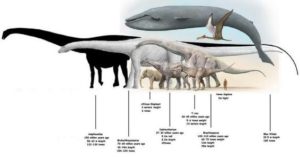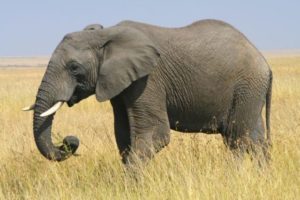Nov
25
Thank God for Elephants and Sauropods
“Less obvious reasons for why God created dinosaurs and elephants is to increase the global availability of nutrients and to permit a greater diversity of life to survive.” — Dr. Hugh Ross
A few of you might remember that I blogged a few years ago about being thankful for sperm whales and other large predators and… their poop. If that intrigues you, well, I invite you to (re-)read the post, in which I cite two articles by Dr. Hugh Ross, where he in turn summarized findings published in two science journals. (Kind of an odd subject for “Thanksgiving”, I know.) Well, this year I have a similar post, also based on an article by Ross, but this time looking at large herbivores of the present and past, rather than carnivores.
Back in the 1980s, environmental zoologist Paul Rees published an interesting study* on the African Bush elephant. This is the largest and heaviest land animal on the Earth today, with bulls averaging over 10 feet tall and approaching 7 tons in weight. Rees showed that, with a food assimilation efficiency of only 22.4%, it takes roughly 21–46 hours between when an elephant eats and when it eventually defecates waste product from that food. In the meantime, the animal has typically roamed tens of miles per day. This means that “they efficiently transport nutrient-rich material throughout their environments.” The soil and plants depend on it. [Note: I imagine the even larger mammoths, mastodons, and similarly-sized herbivorous mammals of the past would have had a similar effect on their environment, as well.]
Recent studies*, however, indicate that sauropods of the Cretaceous Period were even better “mobile fertilizers”. Sauropods were also continuously on the move. They include not only the largest dinosaurs but the largest land animals to have ever lived, with species ranging from ~20 feet to 130 feet in length from nose-tip to tail-tip and weighing up to 130 tons, maybe more. Some of the largest (e.g., Sauroposeidon, Argentinosaurus) existed in the Early to Late Cretaceous. Truly awesome beasts! (And a LOT of feces…)
“Christopher Doughty of the School of Informatics, Computing, and Cyber Systems at Northern Arizona University… compared remnant plant material from coal deposits from the Cretaceous period (145–66 million years ago) with those from the Pennsylvanian subperiod (323–299 million years ago). Plant material nutrients measured 136% more concentrated in the Cretaceous than during the Pennsylvanian. The difference between the two periods was that the Cretaceous had large-bodied herbivores, namely the sauropods, whereas the Pennsylvanian had none at all.”
Nonbiotic processes like weathering were ruled out as sources for the difference.
Four ecologists published a paper* in Palaeontology discussing their analysis of the extreme range of body sizes among dinosaurs in the Cretaceous Period. Regarding the largest of these creatures, they determined from biomechanics that they would have had “food passage times” on the order of days, not hours.
An earlier study* by sixteen biologists provided affirming data, showing that…
“…the very long necks and small heads of the sauropods meant that little mastication could take place in the mouth. The only possible compensating factor would be very long food passage times. [In other words, less chewing means reduced efficiency in digestion.] Such long food passage times and the enormous sizes of these dinosaurs imply that they were defecating far from where they were eating.”
 You might wonder, then, what happens when these huge herbivores are no longer around….
You might wonder, then, what happens when these huge herbivores are no longer around….
“Three ecologists pointed out that during the late Pleistocene (20,000–11,700 years ago), 97 genera of large animals went extinct. They showed that this extinction event reduced the lateral flux of the limiting nutrient phosphorus in Amazonia by more than 98%!
Doughty closed his recent research paper with a call to conserve the remaining large animals on our planet. He cited data showing that the removal of the largest animals likely would reduce nutrient concentrations in their habitats by an additional 130% or more. Evolutionary models show that the increase in maximum biovolume of a factor of 100,000 times that has occurred since the Cambrian explosion 543 million years ago “could not have emerged from a random process” and that this pattern of dramatically increasing body sizes “does not reflect a simple scaling up of widespread and persistent selection for larger size within populations.””
Very interesting conclusions, especially in regards to creation/evolution/ID.
Ross thus concludes,
“[B]oth observational field studies and theoretical biological models [establish that] large-bodied herbivores have played and continue to play a much more important role in increasing the global availability of nutrients critical for maintaining abundant and diverse life-forms than previously acknowledged.”
Thank God for elephants (and their older cousins) and giant herbivorous dinosaurs!
On that note, I wish you all a slightly-belated “Happy Thanksgiving!”
* Links to the studies in question can be found in Ross’s article linked above.
















